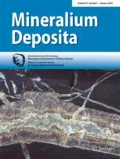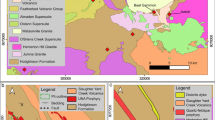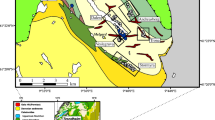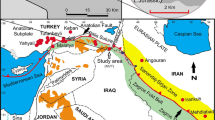Abstract
At the Hämmerlein skarn deposit, located in the western Erzgebirge (Germany), a major cassiterite-dominated Sn mineralization stage is spatially associated with a younger Zn-Cu-In sulfide mineralization stage. In this contribution, we provide the first detailed description of the Zn-Cu-In sulfide mineralization stage, based on field geological observations combined with detailed petrographic studies and electron probe microanalysis data. Indium-rich sulfide mineralization occurs as irregular, semi-massive lenses or as infill of short, discontinuous veinlets that crosscut the cassiterite-bearing skarn assemblage. Indium- and Cu-rich sphalerite and roquesite are found to be closely associated with In-bearing chalcopyrite. The highest In concentrations in sphalerite occur at the rims and along cracks of sphalerite grains. The distribution resembles diffusion profiles, suggesting that the In enrichment is due to an hydrothermal overprint that postdates the initial formation of both sphalerite and chalcopyrite. Textural relations illustrate that the diffusion fronts in sphalerite grains are thicker where they are in contact to anhedral masses of hematite and magnetite. Our observations suggest that In enrichment in sphalerite at the Hämmerlein skarn deposit is due to the decomposition of In-bearing chalcopyrite. The resultant release of Fe led to the formation of hematite and magnetite, whereas Cu and In were incorporated into sphalerite along grain boundaries and micro fractures. Incorporation into the sphalerite lattice took place by coupled substitution of Cu+ + In3+ ↔ 2Zn2+, suggesting that the concurrent availability of Cu and In may be an essential factor to enrich In in sphalerite in hydrothermal ore-forming environments.









Similar content being viewed by others
References
Armstrong JT, McSwiggen P, Nielsen C (2013) A thermal field-emission electron probe microanalyzer for improved analytical spatial resolution. Microsc Anal 27(7):18–22
Bachmann K, Frenzel M, Krause J, Gutzmer J (2017) Advanced identification and quantification of in-bearing minerals by scanning electron microscope-based image analysis. Microsc Microanal:1–11. https://doi.org/10.1017/S1431927617000460
Baker T, van Achterberg E, Ryan CG, Lang JR (2004) Composition and evolution of ore fluids in a magmatic-hydrothermal skarn deposit. Geology 32(2):117. https://doi.org/10.1130/G19950.1
Barton PB Jr, Bethke PM (1987) Chalcopyrite disease in sphalerite: pathology and epidemiology. Am Mineral 72(5–6):451–467
Baumann H, Mathes R, Jefimow W, Schubert E (1975) Geologischer Grundriß Stollensohle der Lagerstätte Hämmerlein–Tellerhäuser 1:10000. SDAG Wismut
Baumann L, Kuschka E, Seifert T (2000) Lagerstätten des Erzgebirges. Enke im Georg Thieme Verlag. New York, Stuttgart
Bente K, Doering T (1993) Solid-state diffusion in sphalerites; an experimental verification of the “chalcopyrite disease”. Eur J Mineral 5(3):465–478
Bente K, Doering T (1995) Experimental studies on the solid state diffusion of Cu + In in ZnS and on “disease”, DIS (diffusion induced segregations), in sphalerite and their geological applications. Mineral Petrol 53(4):285–305. https://doi.org/10.1007/BF01160153
Buckley AN, Skinner WM, Harmer SL, Pring A, Lamb RN, Fan L-J, Yang Y-w (2007) Examination of the proposition that u(II) can be required for charge neutrality in a sulfide lattice—Cu in tetrahedrites and sphalerite. Can J Chem 85(10):767–781
Burke EAJ, Kieft C (1980) Roquesite and Cu-In-bearing sphalerite from Långban, Bergslagen, Sweden. Can Mineral 18(3):361–363
Cherniak DJ (2010) Diffusion in carbonates, fluorite, sulfide minerals, and diamond. Rev Mineral Geochem 72(1):871. https://doi.org/10.2138/rmg.2010.72.19
Cook NJ, Ciobanu CL, Pring A, Skinner W, Shimizu M, Danyushevsky LV, Saini-Eidukat B, Melcher F (2009) Trace and minor elements in sphalerite: a LA-ICPMS study. Geochim Cosmochim Acta 73(16):4761–4791. https://doi.org/10.1016/j.gca.2009.05.045
Cook NJ, Ciobanu CL, Williams T (2011a) The mineralogy and mineral chemistry of indium in sulphide deposits and implications for mineral processing. Hydrometallurgy 108(3–4):226–228. https://doi.org/10.1016/j.hydromet.2011.04.003
Cook NJ, Sundblad K, Valkama M, Nygård R, Ciobanu CL, Danyushevsky LV (2011b) Indium mineralisation in A-type granites in southeastern Finland: insights into mineralogy and partitioning between coexisting minerals. Chem Geol 284(1–2):62–73. https://doi.org/10.1016/j.chemgeo.2011.02.006
Cook NJ, Ciobanu CL, Brugger J, Etschmann B, Howard DL, de Jonge MD, Ryan C, Paterson D (2012) Determination of the oxidation state of Cu in substituted Cu-In-Fe-bearing sphalerite via μ-XANES spectroscopy. Am Mineral 97(2–3):476–479. https://doi.org/10.2138/am.2012.4042
Dill HG, Garrido MM, Melcher F, Gomez MC, Weber B, Luna LI, Bahr A (2013) Sulfidic and non-sulfidic indium mineralization of the epithermal Au–Cu–Zn–Pb–Ag deposit San Roque (Provincia Rio Negro, SE Argentina)—with special reference to the “indium window” in zinc sulfide. Ore Geol Rev 51:103–128. https://doi.org/10.1016/j.oregeorev.2012.12.005
EU Commission (2014) Critical raw materials for the EU. Report of the Ad hoc Working Group on Defining Critical Raw Materials, Bruessels
Fandrich R, Gu Y, Burrows D, Moeller K (2007) Modern SEM-based mineral liberation analysis. Int J Miner Process 84(1–4):310–320
Förster H, Romer RL (2010) Carboniferous magmatism. In: Linnemann U, Romer RL (eds) Pre-Mesozoic geology of Saxo-Thuringia—from the Cadomian active margin to the Variscan Orogen. Schweizbart, Stuttgart
Förster H, Tischendorf G, Trumbull RB, Gottesmann B (1999) Late-collisional granites in the Variscan Erzgebirge, Germany. J Petrol 40(11):1613–1645. https://doi.org/10.1093/petroj/40.11.1613
Franke W (2000) The mid-European segment of the Variscides: tectonostratigraphic units, terrane boundaries and plate tectonic evolution. Geol Soc Lond, Spec Publ 179(1):35–61. https://doi.org/10.1144/GSL.SP.2000.179.01.05
Frenzel M (2016) The distribution of gallium, germanium and indium in conventional and non-conventional resources—implications for global availability. Thesis, TU Bergakademie Freiberg
Frenzel M, Hirsch T, Gutzmer J (2016) Gallium, germanium, indium, and other trace and minor elements in sphalerite as a function of deposit type—a meta-analysis. Ore Geol Rev 76:52–78. https://doi.org/10.1016/j.oregeorev.2015.12.017
Frenzel M, Mikolajczak C, Reuter MA, Gutzmer J (2017) Quantifying the relative availability of high-tech by-product metals—the cases of gallium, germanium and indium. Resour Policy 52:327–335. https://doi.org/10.1016/j.resourpol.2017.04.008
Goh SW, Buckley AN, Lamb RN, Rosenberg RA, Moran D (2006) The oxidation states of copper and iron in mineral sulfides, and the oxides formed on initial exposure of chalcopyrite and bornite to air. Geochim Cosmochim Acta 70(9):2210–2228. https://doi.org/10.1016/j.gca.2006.02.007
Hösel G (2003) Die polymetallische Skarnlagerstätte Pöhla-Globenstein, Bergbaumonographie. Bergbau in Sachsen, vol 8, Freiberg
Johan Z (1988) Indium and germanium in the structure of sphalerite: an example of coupled substitution with copper. Mineral Petrol 39(3–4):211–229. https://doi.org/10.1007/BF01163036
Jonsson E, Hogdahl K, Majka J, Lindeberg T (2013) Roquesite and associated indium-bearing sulfides from a Paleoproterozoic carbonate-hosted mineralization: Lindbom’s prospect, Bergslagen, Sweden. Can Mineral 51(4):629–641. https://doi.org/10.3749/canmin.51.4.629
Kästner J (2016) Detailed investigations of skarn lithologies and tin mineralisation of the Hämmerlein seam (+590 m level) in the Pöhla-Tellerhäuser ore district (Erzgebirge, Germany). Master Thesis, TU Bergakademie Freiberg
Kern M, Möckel R, Krause J, Teichmann J, Gutzmer J (2017) Calculating the deportment of a fine-grained and compositionally complex Sn skarn with a modified approach for automated mineralogy. Miner Eng. https://doi.org/10.1016/j.mineng.2017.06.006
Kieft K, Damman AH (1990) Indium-bearing chalcopyrite and sphalerite from the Gåsborn area, west Bergslagen, Central Sweden. Mineral Mag 54:109–112
Kissin SA, Owens DAR (1989) The relatives of stannite in the light of new data. Can Mineral 27(4):673–688
Kossmat F (1927) Gliederung des varistischen Gebirgsbaues. Abhandlungen des Sächsischen Geologischen Landesamtes 1:1–39
Kroner U, Romer RL (2013) Two plates—many subduction zones: the Variscan orogeny reconsidered. Gondwana Res 24(1):298–329. https://doi.org/10.1016/j.gr.2013.03.001
Kröner A, Willner PA (1998) Time of formation and peak of Variscan HP-HT metamorphism of quartz-feldspar rocks in the central Erzgebirge, Saxony, Germany. Contrib Mineral Petrol 132(1):1–20. https://doi.org/10.1007/s004100050401
Leonhardt D (1999) Geologische Karte des Freistaates Sachsen 1:25000, Blatt 5543 Kurort Oberwiesenthal. Sächsisches Landesamt für Umwelt und Geologie, Dresden
Leonhardt D (2009) Geologische Karte des Freistaates Sachsen 1:25000, Blatt 5442 Aue. Sächsisches Landesamt für Umwelt und Geologie, Dresden
Leutwein F (1943) Vorkommen und Gewinnung von Indium. Forschungslaboratorium des Bergreviers Freiberg (Sächsisches Staatsarchiv, Bergarchiv Freiberg, 40030 Oberbergamt (neu) - staatliche Lagerstättenforschungsstelle, Nr. 1–0261), Freiberg, Germany
Li Y, Kawashima N, Li J, Chandra AP, Gerson AR (2013) A review of the structure, and fundamental mechanisms and kinetics of the leaching of chalcopyrite. Adv Colloid Interf Sci 197–198:1–32. https://doi.org/10.1016/j.cis.2013.03.004
Márquez-Zavalía MF, Galliski MÁ, Drábek M, Vymazalová A, Watanabe Y, Murakami H, Bernhardt H (2014) Ishiharaite, (Cu,Ga,Fe,In,Zn)S, a new mineral from the Capillitas Mine, northwestern Argentina. Can Mineral. https://doi.org/10.3749/canmin.1400064
Matte P (1991) Accretionary history and crustal evolution of the Variscan belt in Western Europe. Tectonophysics 196(3):309–337. https://doi.org/10.1016/0040-1951(91)90328-P
Meinert LD, Dipple GM, Nicolescu S (2005) World skarn deposits. Economic Geology 100th Anniversary Volume, 299–336
Murakami H, Ishihara S (2013) Trace elements of indium-bearing sphalerite from tin-polymetallic deposits in Bolivia, China and Japan: a femto-second LA-ICPMS study. Ore Geol Rev 53:223–243. https://doi.org/10.1016/j.oregeorev.2013.01.010
Nance RD, Gutiérrez-Alonso G, Keppie JD, Linnemann U, Murphy JB, Quesada C, Strachan RA, Woodcock NH (2010) Evolution of the Rheic Ocean. Gondwana Res 17(2–3):194–222. https://doi.org/10.1016/j.gr.2009.08.001
Nickel EH (1992) Solid solutions in mineral nomenclature. Mineral Petrol 46(1):49–53. https://doi.org/10.1007/BF01160701
Ohta E (1989) Occurrence and chemistry of indium-containing minerals from the Toyoha Mine, Hokkaido, Japan. Min Geol 39(218):355–372
Osbahr I, Krause J, Bachmann K, Gutzmer J (2015) Efficient and accurate identification of platinum-group minerals by a combination of mineral liberation and electron probe microanalysis with a new approach to the offline overlap correction of platinum-group element concentrations. Microsc Microanal 21(5):1080–1095. https://doi.org/10.1017/S1431927615000719
Pattrick RAD, Dorling M, Polya DA (1993) TEM study of indium- and copper-bearing growth-banded sphalerite. Can Mineral 31(1):105–117
Pattrick RAD, Mosselmans JFW, Charnock JM (1998) An X-ray absorption study of doped sphalerites. Eur J Mineral 10(2):239
Pavlova GG, Palessky SV, Borisenko AS, Vladimirov AG, Seifert T, Phan LA (2015) Indium in cassiterite and ores of tin deposits. Ore Geol Rev 66:99–113. https://doi.org/10.1016/j.oregeorev.2014.10.009
Pearce CI, Pattrick R, Vaughan DJ, Henderson C, van der Laan G (2006) Copper oxidation state in chalcopyrite: mixed Cu d9 and d10 characteristics. Geochim Cosmochim Acta 70(18):4635–4642. https://doi.org/10.1016/j.gca.2006.05.017
von Quadt A, Günther D (1999) Evolution of Cambrian eclogitic rocks in the Erzgebirge: a conventional and LA-ICP-MS U-Pb zircon and Sm-Nd study. Terra Nostra 99(1):164
Reich F, Richter T (1863) Ueber das Indium. J Prakt Chem 90(1):172–176. https://doi.org/10.1002/prac.18630900122
Rötzler K, Plessen B (2010) The Erzgebirge: a pile of ultrahigh- to low-pressure nappes of Early Palaeozoic rocks and their Cadomian basement. In: Linnemann U, Romer RL (eds) Pre-Mesozoic geology of Saxo-Thuringia—from the Cadomian active margin to the Variscan Orogen, Schweizbart, Stuttgart, pp 253–270
Schmädicke E, Evans WB (1997) Garnet-bearing ultramafic rocks from the Erzgebirge, and their relation to other settings in the Bohemian Massif. Contrib Mineral Petrol 127(1):57–74. https://doi.org/10.1007/s004100050265
Schorr S, Wagner G (2005) Structure and phase relations of the Zn2x(CuIn)1−xS2 solid solution series. J Alloys Compd 396(1–2):202–207. https://doi.org/10.1016/j.jallcom.2004.12.018
Schuppan W, Hiller A (2012) Die Komplexlagerstätten Tellerhäuser und Hämmerlein: Uranbergbau und Zinnerkundung in der Grube Pöhla der SDAG Wismut. Bergbau in Sachsen, Band 17, Freiberg
Schwarz-Schampera U (2014) Indium. In: Gunn G (ed) Critical metals handbook. Wiley, Hoboken, pp 204–229
Schwarz-Schampera U, Herzig PM (2000) Indium: geology, mineralogy and economics. Springer-Verlag, Berlin
Seifert T (2008) Metallogeny and petrogenesis of lampophyres in the mid-European Variscides: post-Collosional magmatism and its relationship to late-Variscan ore forming processes in the Erzgebirge (Bohemian Massif). IOS Press, Rotterdam
Seifert T, Sandmann D (2006) Mineralogy and geochemistry of indium-bearing polymetallic vein-type deposits: implications for host minerals from the Freiberg district, eastern Erzgebirge, Germany. Ore Geol Rev 28(1):1–31. https://doi.org/10.1016/j.oregeorev.2005.04.005
Seward TM, Henderson CMB, Charnock JM (2000) Indium(III) chloride complexing and solvation in hydrothermal solutions to 350°C: an EXAFS study. Chem Geol 167(1–2):117–127. https://doi.org/10.1016/S0009-2541(99)00204-1
Shimizu T, Morishita Y (2012) Petrography, chemistry, and near-infrared microthermometry of indium-bearing sphalerite from the Toyoha polymetallic deposit, Japan. Econ Geol 107(4):723–735. https://doi.org/10.2113/econgeo.107.4.723
Shimizu M, Kato A, Shiozawa T (1986) Sakuraiite; chemical composition and extent of (Zn, Fe)In-for-CuSn substitution. Can Mineral 24(2):405–409
Sinclair WD, Kooiman GJA, Martin DA, Kjarsgaard IM (2006) Geology, geochemistry and mineralogy of indium resources at Mount Pleasant, New Brunswick, Canada. Ore Geol Rev 28(1):123–145. https://doi.org/10.1016/j.oregeorev.2003.03.001
Tichomirowa M, Leonhardt D (2010) New age determinations (Pb/Pb zircon evaporation, Rb/Sr) on the granites from Aue-Schwarzenberg and Eibenstock, western Erzgebirge, Germany. Z Geol Wiss 38(2–3):99–123
Treliver Minerals Ltd (2015a) Tellerhäuser Project resource statement: press release from 13th March 2015. http://www.anglosaxony.com/assets/file/Press%20Release%20Mar%202015.pdf. Accessed 30 May 2016
Treliver Minerals Ltd (2015b) Westerzgebirge project Hammerlein-Tellerhauser: long Section through Adit. http://www.anglosaxony.com/projects/germany/tellerhauser. Accessed 30 May 2016
Valkama M, Sundblad K, Cook NJ, Ivashchenko VI (2016) Geochemistry and petrology of the indium-bearing polymetallic skarn ores at Pitkäranta, Ladoga Karelia, Russia. Mineral Deposita 51(6):823–839. https://doi.org/10.1007/s00126-016-0641-4
Wood SA, Samson IM (2006) The aqueous geochemistry of gallium, germanium, indium and scandium. Ore Geol Rev 28(1):57–102. https://doi.org/10.1016/j.oregeorev.2003.06.002
Acknowledgments
We would like to thank Nigel Cook and Erik Jonsson for their constructive comments that improved a former version of this manuscript significantly. H. Albert Gilg and Bernd Lehmann are thanked for the editorial handling. We sincerely thank Marco Roscher and Lars Starke (Saxore Bergbau GmbH) for the support with the sample collection; Frank Weißflog and the Besucherbergwerk Zinnkammern Pöhla e. V. for access to the underground mine; Max Frenzel, Tom Járóka, and Reinhard Kleeberg for insightful discussions; and Andreas Bartzsch, Roland Würkert, and Michael Stoll for sample preparation. The geographic map of Germany is based on data generated with generic mapping tools, GMT 5 (https://www.soest.hawaii.edu/gmt/).
Funding
This work was funded by the Biohydrometallurgical Center for Strategic Elements (BHMZ) of the Dr. Erich-Krüger-Foundation, Technische Universität Bergakademie Freiberg.
Author information
Authors and Affiliations
Corresponding author
Additional information
Editorial handling: A. Gilg
Electronic supplementary material
ESM 1
(XLSX 145 kb).
ESM 2
EPMA element distribution maps of a large sphalerite IIc grain (Sp IIc) that is surrounded by chalcopyrite (Ccp) and Fe oxides (magnetite and hematite); resolution 1 pixel ≙ 3 µm. a Zn EDS signal with position of a high resolution beam scan (2-6_10b Map 3-a) in e–g. b Fe Kα X-ray signal. c In Lα X-ray signal. d Cu Kα X-ray signal. e Cu Lα X-ray signal, resolution 1 pixel ≙ 170 nm. f In Lα X-ray signal. g Fe Lα X-ray signal (GIF 748 kb).
Rights and permissions
About this article
Cite this article
Bauer, M.E., Seifert, T., Burisch, M. et al. Indium-bearing sulfides from the Hämmerlein skarn deposit, Erzgebirge, Germany: evidence for late-stage diffusion of indium into sphalerite. Miner Deposita 54, 175–192 (2019). https://doi.org/10.1007/s00126-017-0773-1
Received:
Accepted:
Published:
Issue Date:
DOI: https://doi.org/10.1007/s00126-017-0773-1




